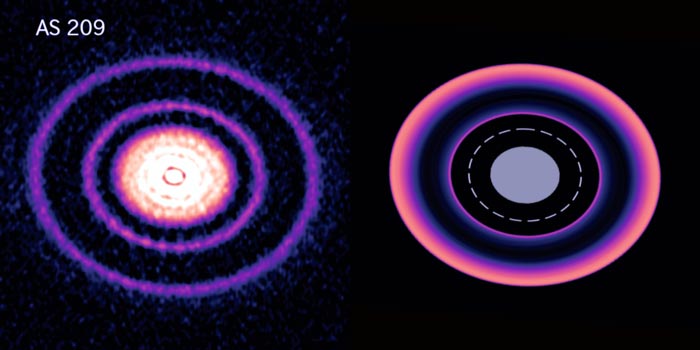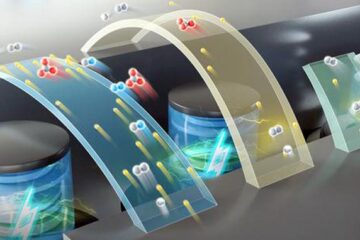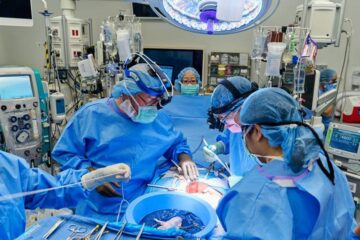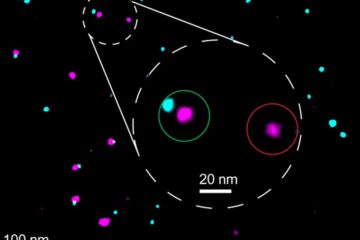Simulations provide clue to missing planets mystery

A protoplanetary disk as observed by ALMA (left), and a protoplanetary disk during planetary migration, as obtained from the ATERUI II simulation (right). The dashed line in the simulation represents the orbit of a planet, and the gray area indicates a region not covered by the computational domain of the simulation.
Credit: Kazuhiro Kanagawa, ALMA(ESO/NAOJ/NRAO)
Forming planets are one possible explanation for the rings and gaps observed in disks of gas and dust around young stars. But this theory has trouble explaining why it is rare to find planets associated with rings. New supercomputer simulations show that after creating a ring, a planet can move away and leave the ring behind. Not only does this bolster the planet theory for ring formation, the simulations show that a migrating planet can produce a variety of patterns matching those actually observed in disks.
Young stars are encircled by protoplanetary disks of gas and dust. One of the world’s most powerful radio telescope arrays, ALMA (Atacama Large Millimeter/submillimeter Array), has observed a variety of patterns of denser and less dense rings and gaps in these protoplanetary disks. Gravitational effects from planets forming in the disk are one theory to explain these structures, but follow-up observations looking for planets near the rings have largely been unsuccessful.
In this research a team from Ibaraki University, Kogakuin University, and Tohoku University in Japan used the world’s most powerful supercomputer dedicated to astronomy, ATERUI II at the National Astronomical Observatory of Japan, to simulate the case of a planet moving away from its initial formation site. Their results showed that in a low viscosity disk, a ring formed at the initial location of a planet doesn’t move as the planet migrates inwards. The team identified three distinct phases. In Phase I, the initial ring remains intact as the planet moves inwards. In Phase II, the initial ring begins to deform and a second ring starts forming at the new location of the planet. In Phase III, the initial ring disappears and only the latter ring remains.
These results help explain why planets are rarely observed near the outer rings, and the three phases identified in the simulations match well with the patterns observed in actual rings. Higher resolution observations from next-generation telescopes, which will be better able to search for planets close to the central star, will help determine how well these simulations match reality.
These results appeared as K.D. Kanagawa et al. “Dust rings as a footprint of planet formation in a protoplanetary disk” in The Astrophysical Journal on November 12, 2021.
Journal: The Astrophysical Journal
DOI: 10.3847/1538-4357/ac282b
Method of Research: Computational simulation/modeling
Subject of Research: Not applicable
Article Title: Dust rings as a footprint of planet formation in a protoplanetary disk
Article Publication Date: 12-Nov-2021
Media Contact
Hinako Fukushi
NAOJ
cfca-pr@cfca.nao.ac.jp
Original Source
https://www.nao.ac.jp/en/news/science/2021/20211113-cfca.html
All latest news from the category: Physics and Astronomy
This area deals with the fundamental laws and building blocks of nature and how they interact, the properties and the behavior of matter, and research into space and time and their structures.
innovations-report provides in-depth reports and articles on subjects such as astrophysics, laser technologies, nuclear, quantum, particle and solid-state physics, nanotechnologies, planetary research and findings (Mars, Venus) and developments related to the Hubble Telescope.
Newest articles

High-energy-density aqueous battery based on halogen multi-electron transfer
Traditional non-aqueous lithium-ion batteries have a high energy density, but their safety is compromised due to the flammable organic electrolytes they utilize. Aqueous batteries use water as the solvent for…

First-ever combined heart pump and pig kidney transplant
…gives new hope to patient with terminal illness. Surgeons at NYU Langone Health performed the first-ever combined mechanical heart pump and gene-edited pig kidney transplant surgery in a 54-year-old woman…

Biophysics: Testing how well biomarkers work
LMU researchers have developed a method to determine how reliably target proteins can be labeled using super-resolution fluorescence microscopy. Modern microscopy techniques make it possible to examine the inner workings…





















